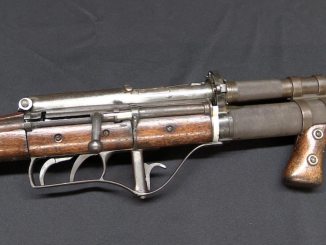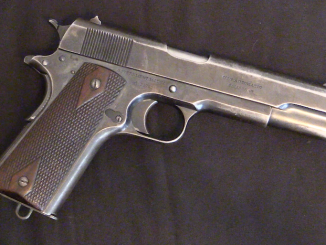One of the many revolver systems designed to work around the Rollin White patent was the Pant’s Patent cupfire revolver, made by Merwin & Bray in several calibers (.28, .30, and .42). This particular example is a nice on in .42 (which is the diameter of the cartridge case; the projectile is actually .39 caliber). The cupfire system was similar technically to rimfire, but with the priming compound in the base of the hollow cup at the end of the cartridge case. This allowed it to be loaded from the front of the cylinder, and fired by a hammer striking through a smaller hole in the rear of the cylinder.
- Six Shooters, Arcade Fire, and IP Hell | iState
- Six Shooters, Arcade Fire, and IP Hell | NewsFire- Setting Your News on Fire
- Six Shooters, Arcade Fire, and IP Hell | Paul Gordon
- Six Shooters, Arcade Fire, and IP Hell | VisPrivus
- Six Shooters, Arcade Fire, and IP Hell | Trump Gaze
- The Gadsden Review | Six Shooters, Arcade Fire, and IP Hell
- Six Shooters, Arcade Fire, and IP Hell | Saving Liberty




When we think about it, our 2nd Amendment protected “Right” to keep and bear arms has been infringed from the get-go.
How does something as simple as drilling a revolver cylinder get a patent?
Does anybody of you have link to original Rollin White patent?
It is described here: http://en.wikipedia.org/wiki/Rollin_White
Apparently it wasn’t simple “bore-through” cylinder but more advanced design – as it have cylinder aswell box magazine.
“How does something as simple as drilling a revolver cylinder get a patent?”
It looks like Rollin White was simply patent troll – as you can see there exist even in 19th century not only in our times (see “Apple patent: Rounded Corners” for example of modern)
“This allowed it to be loaded from the front of the cylinder”
It reminds me Soviet Rikhter R-23 auto-cannon, the cartridge from belt is rammed to 4-chamber drum from forward aswell ejecting frontwards. One interesting feature is additional “pyrotechnic” cartridge in cause of fail-to-ignite powder in normal cartridge. Rikhter R-23 can fire up to 2500rpm and is armament of Tu-22 bomber (mounted tail turret), it is firing 23x260mm cartridge having electric primer, it has polygonal rifling
The R-23 and its mount DK-20 proved be unreliable and inaccurate, it wasn’t used on any other soviet aeroplane other than Tu-22
Under most countries’ patent laws, all a device or concept needs to be eligible is that the patent applicant be able to demonstrate that the idea was new and had not previously been patented in that country on the day he filed his patent application.
Some things are considered to be ineligible on the basis of being common knowledge. The U.S. Patent Office, and the old Patent Court, could get very short with the perennial fanatic who tries to patent fire and/or the wheel. (Yes, this still happens at least once every couple of years, even today.)
At the time, not only was a “bored-through” cylinder considered a new idea, the revolver itself was as well. Samuel Colt held a patent on the “revolving cylinder type repeating action firearm” from 1834 to 1851. Others had built such arms before (see “Collier flintlock revolver”), but Colt was the first to design one that had reliable cylinder indexing (making sure the chamber under the hammer was correctly lined up with the barrel before firing).
The Rollin White patent, strictly speaking, was dubious. The French Lefaucheux pinfire revolver patent of 1852 specified a “bored-through” cylinder as part of the patent, because of course it’s very difficult to load a pinfire round from the front. (It requires leaving the “pin” out until the round is in pace, making sure the “hole” in the cartridge case is properly aligned with the “hole” in the chamber, inserting the pin and making sure it doesn’t fall out, etc. IOW, more trouble than it’s worth.)
Under U.S. law, the French patent was supposed to be honored by the U.S. Patent Office under reciprocity. (At the time, we considered France our only actual foreign ally.) Somehow, that little detail didn’t get mentioned in the Rollin White affair.
BTW, the story that Sam Colt turned White down before he went to S&W is only about half true. White’s original patent model still exists. If you have the book Gun Collector’s Digest, Volume 1 (Digest Books, 1974), it’s shown on p. 45. It used a feed system to insert paper cartridges into the chambers from behind, hence the need for the bored-through cylinder; cocking the hammer was supposed to operate the feed system.
It’s almost an exact reverse of the British “Silver & Fletcher Hammer” ejection system sometimes seen on solid frame Webley “Bulldog” revolvers from 1878 to 1890 or so. In many ways, it resembles the “revolver-breech” automatic cannon developed near the end of WW2. Unlike the cannon, but like the “S&F hammer”, it didn’t work well, if at all.
White’s idea apparently was to be able to provide sustained fire with a revolving-type action. Colt thought the system was impractical. White insisted that it was an “all or nothing” thing (he wanted the revolvers made with his feed system, or not at all), and he wanted the patent in his name for royalties (White was a contract worker for Colt, not a salaried employee). Colt was aware White had a reputation for hunting up existing foreign patents and filing them in his own name; he had been sued several times as a result.
Colt concluded that White’s “patent” wasn’t workable, and he was tired of putting up with White anyway. White walked, and took his idea to Horace Smith and Daniel Baird Wesson, who at the time were busy losing money on the first “Smith & Wesson” firearms, which were actually the Walter Hunt-designed “Volcanic” lever-actions. Yes, they were sold as “Smith & Wesson” brand guns from 1855 to 1857, when the pair sold out to Oliver F. Winchester. (He and Benjamin Tyler Henry soon started making a lot of money by manufacturing the new and improved Henry lever-action rifle- but that, as Conan’s chronicler said, is another story.)
S&W took the money from Winchester, the bored-through cylinder patent from White, and a basic revolver designed by C.B. Richards, and went into the revolver business.
White got a royalty on every revolver made with “his” bored-through cylinder. But the royalty agreement stipulated that he “protect the patent” by suing infringers at his own expense, not Smith & Wesson’s. As such, White ended up bankrupting himself over the next twelve years, while Smith & Wesson ended up making a lot of money making and selling metallic-cartridge revolvers.
Most suits White brought against actual gun makers who made revolvers that “violated” his patent ended up with those makers being required to cease and desist and surrender any and all guns made to S&W. This is why collectors today often encounter early metallic-cartridge revolvers like the Moore, Allen, etc., with marks like “Made For Smith & Wesson” on the barrel and/or frame.
While “letters” patents normally ran for 17 years back then, the White patent expired in 1869, after only 12 years. S&W filed for an extension, the Patent Office approved it, the Supreme Court ordered them to reverse that, and their appeal to the President (Grant) was turned down for “reasons of commerce and national security”. Grant apparently then gave the Patent office a good talking-to, along the lines of “you had the French patent on the books in 1857; why didn’t you turn this one down?”
The most likely reason is that somebody (probably with the initials “S” and “W”) bribed someone at the Patent Office to be a bit “lax” in their patent search prior to granting the White patent. This was all too common at the U.S. Patent Office at the time. It’s noteworthy that President Grant’s campaign against corruption in government began with the Commerce Department- which included the Patent Office.
The “Rollin White affair” was one of the longest and most convoluted messes in U.S. Patent Office history. Among other things, it ensured that the American Civil War would be fought with percussion revolvers in the hands of cavalry for the most part, instead of metallic-cartridge arms. it also ensured that foreign armies and navies would adopt advanced breechloading revolvers years before the U.S. forces got them in appreciable numbers.
Yes, this no doubt did affect world history. And probably not for the better.
cheers
eon
RW patent set back US revolver development quite a few years back. By the time it expired and US cartridge revolvers appeared they were often quite a bit dated compared to better European models, like Tranters and Gassers. Few “exotics” that tried new things died out or did not even see production unfortunately (Winchester side-ejecting cylinder prototypes, Merwin Hulbert etc.).
It took up the Colt New Army/Navy to catch up and even more to get good reliable DA mechanism (Colt Positive series and S&W M&P).
“DARN YOU WHITE! YOU ARE THE WORST ROOMMATE!” Do you think most American arms makers apart from Smith and Wesson screamed this?
Mid-to-late 19th Century: Do we win the war honestly Middle Ages style or do we just KILL everyone on the other team from half a kilometer away? I think you would prefer killing one out of every three opponents on the other team from half a kilometer away and cause the other two of the three to run away screaming mommy. As far as patent trolling went, European gun makers ignored foreign patents simply because there was no international patent office at the time!
If the US Army and the French Foreign Legion got into a fight in 1865, who would win what?
European makers did not ignore patents, there was a complicated network how patents worked. Take for example hammer safety on Gasser (half-cock a hammer and it is drop safe – really drop safe as hammer is held back not by little easily broken notch but by two thick steel pins that went into action, however unlike standard half-cock you could still use DA mode, which made it quite popular). Gasser actually payed royalties for it to Belgian inventor that came with it. Webley, Tranter and Adams (and a lot of others) tried using it w/o paying, got sued (as UK recognized Belgian patent) and had to stop using it. Hence early Webley models were quite drop safe, while subsequent solid frames (like RIC) were not.
Difference to US patent law was that European patents had much shorter expiration period, eg. Gasser got 5 years patent on it’s revolver, and it was actually respected by most manufacturers, copies started appearing only about 1874-75,, about 6-7 years after patent (1868).
If we keep our sense of humor, patent law and attorneys are funny as a barrel of non-copyrighted monkeys.
Anyone can get small lathes, mills, presses, grinders, you name it.
Are all your videos going to be hosted on this annoying add ridden thing now? What happened to youtube?
For the time being, I am also posting all my video content on YouTube. However, the advertising on Full30 makes a far, far better return for me than YouTube (nearly 10 times better). This web site is my full time job, and it has to be monetized in order to make that work. I am always looking for the best compromise in keeping the information here freely available while still generating enough income to let me continue doing it. I think a 15-second ad on a video is a reasonable tradeoff – certainly a lot better than putting the whole site behind a paywall.